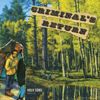 Important Records describes this seventh(!) solo album by Grails/Om drummer Emil Amos as “going toe to toe with Roger Waters in the race to become the most bitter songwriter in the world”, but I don’t quite see it (too bad, as I love bitterness). Instead, it seems like an exuberant and odd (though sometimes surprisingly successful) collision between existentialist introversion and the virile extroversion of the best classic rock.
Important Records describes this seventh(!) solo album by Grails/Om drummer Emil Amos as “going toe to toe with Roger Waters in the race to become the most bitter songwriter in the world”, but I don’t quite see it (too bad, as I love bitterness). Instead, it seems like an exuberant and odd (though sometimes surprisingly successful) collision between existentialist introversion and the virile extroversion of the best classic rock.
Criminal’s Return is cleverly frontloaded with the extremely impressive “From Now On,” which boasts elegantly melancholy piano and a heavy, majestic organ crescendo that any ‘70s prog band would’ve been thrilled to have on their album. The rest of the album never quite hits that level again, but that opening proved very effective at sucking me into the album in hopes of hearing more such gems. That is not to say the rest of the album is a disappointment; far from it, in fact. Nearly every song contains at least one cool idea or memorable part, but all the elements never quite cohere as perfectly again.
Amos is a surprisingly adept multi-instrumentalist, given his day job as a percussionist. While the drumming here is quite good, it is not especially flashy (though Amos locks into some excellent swaggering, laidback grooves). Instead, Amos saves the pyrotechnics for his guitar playing, peppering the album with cool dual-guitar harmonizing and dramatic arena rock-worthy riffs (the instrumental “Arranged Release” is especially packed with six-string heroics, though the slide guitar in “Thorns” is also pretty inspired). He’s also quite an impressive songwriter and arranger, as most of the songs are uncluttered, hook-y, and unfold in a coherent and dynamically satisfying fashion.
There are some weak spots, however: Emil’s downcast, understated vocals and the album’s lack of stylistic focus. Amos’ vocals are definitely not bad by any means, but they are too deadpan to effectively carry the strong songs beneath them (as vocals inevitably become the focal point whenever they appear). It’s pretty frustrating actually, because his vocal melodies are usually quite good and he even pulls off some America-esque multipart harmonies in places. As for the album’s focus, Criminal’s Return is a bit too varied and overt in displaying its influences. While a lot of the album is steeped in classic/prog rock, there are also some clear nods to Will Oldham, Elliot Smith, post-rock, Sebadoh, and analog synth space music (as in “Criminal’s Return Pt. II”).
Of course, part of that schizophrenia might be due to the fact that there are recordings from 2005-2009 included here (though Amos has a history of confounding disparities, such as including a Daniel Johnston/Jad Fair cover on an album named after an Oswald Spengler book). Unexpectedly, the three songs from 2005 are probably the album’s best (and they notably feature the last violin recordings of vanished Grails member Timothy Horner to boot). I’m certainly curious as to why it took Amos three albums to get around to releasing them. Criminal's Return seems like it may be intended as some sort of (very) loose "revenge fantasy" concept album, so maybe this is just the first time they fit somewhere thematically. It seems doubtful though.
Despite its relatively minor flaws, Criminal’s Return shows that Holy Sons is as serious a project as anything else Amos has been involved with. It may be lo-fi and a bit unfocused, but it is also teeming with great ideas and good songs that would not quite fit on Om or Grails albums. There are some guitar parts on this album that are awesome and iconic in an unselfconscious and unironic way that is rarely, if ever, found in indie rock circles (perhaps Doug Martsch needs to start watching his back). Unless Om ends up swallowing all of his time, Amos seems well on course for recording a monster of album someday. Of course, perhaps he secretly already has.
Samples:
Read More

